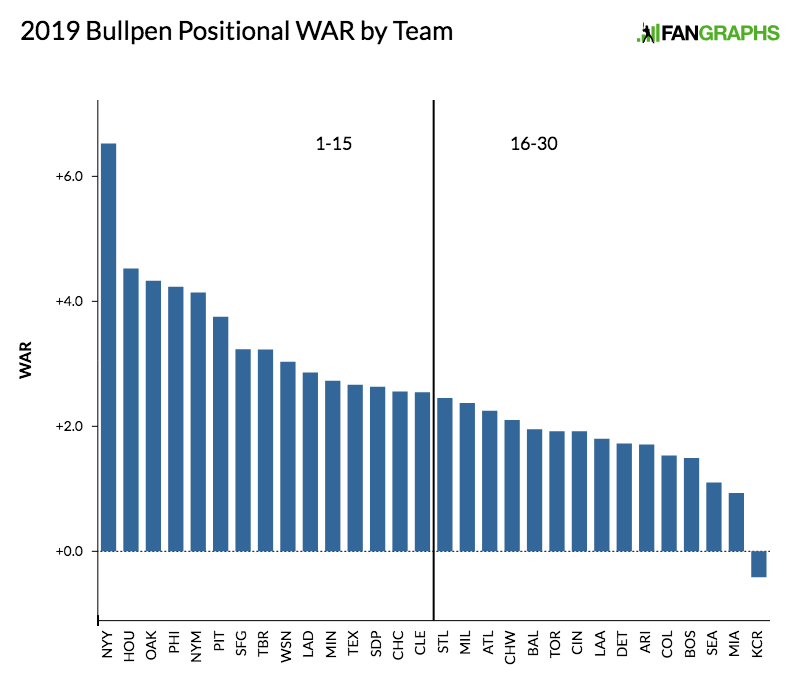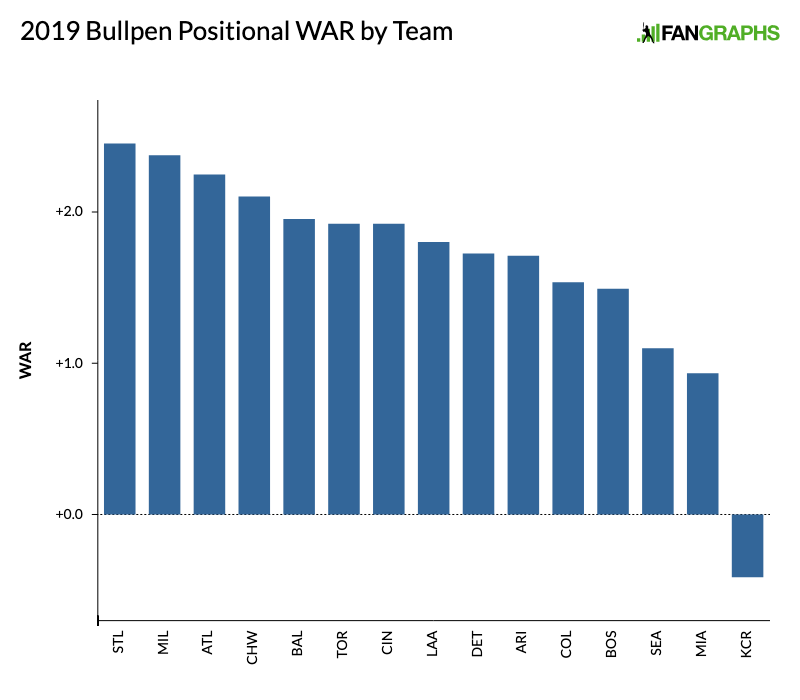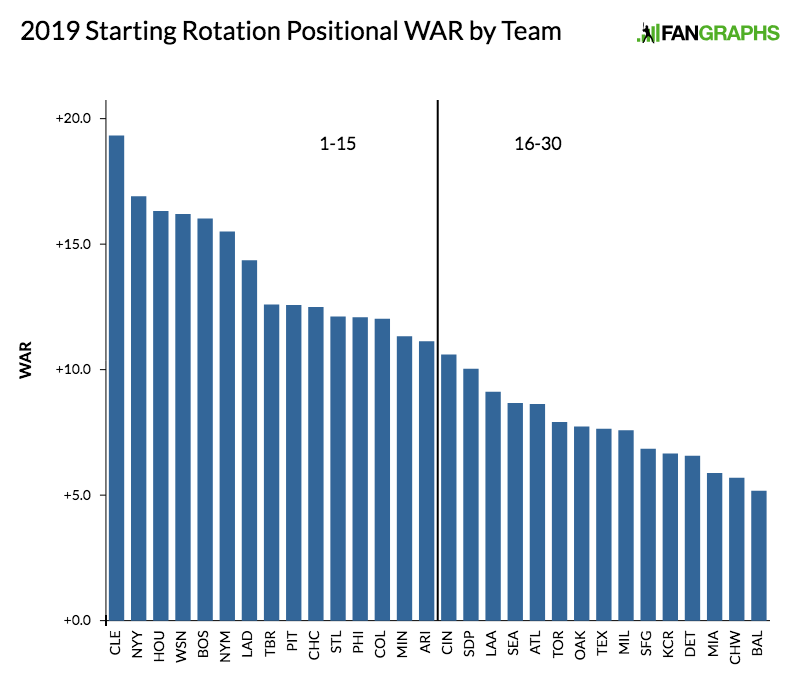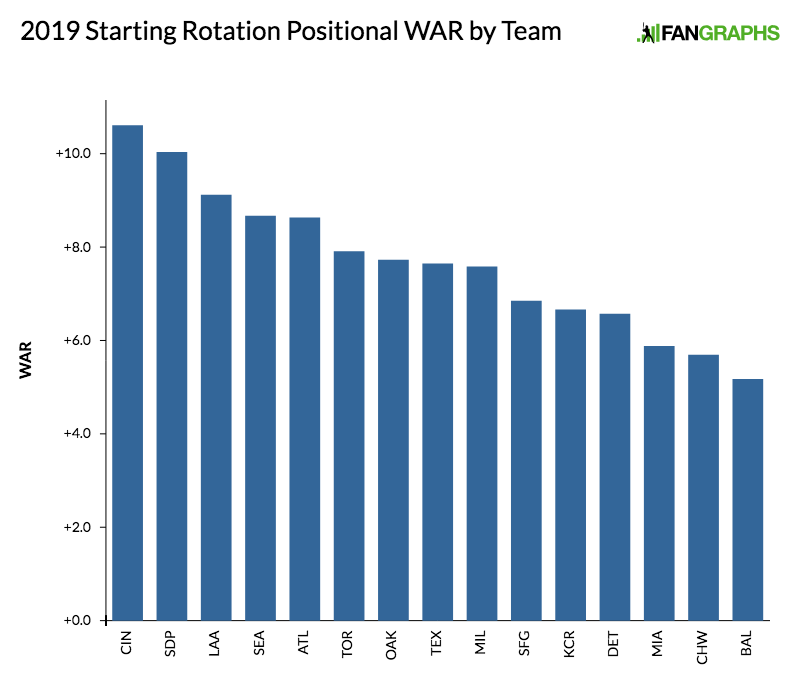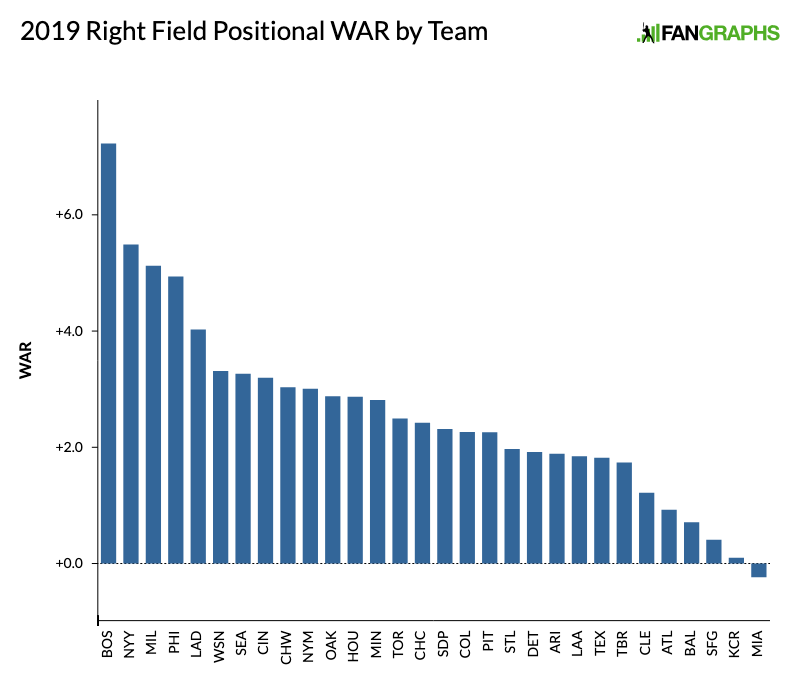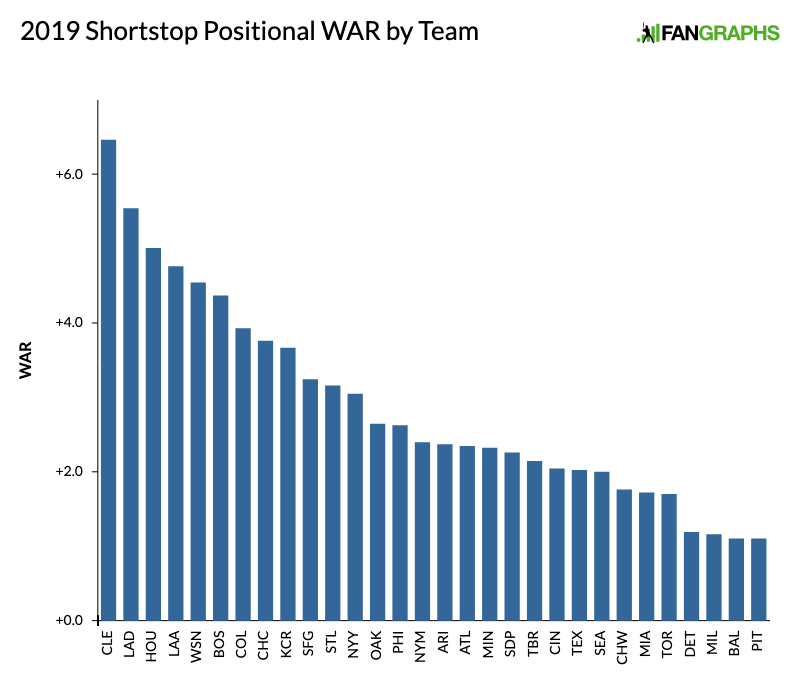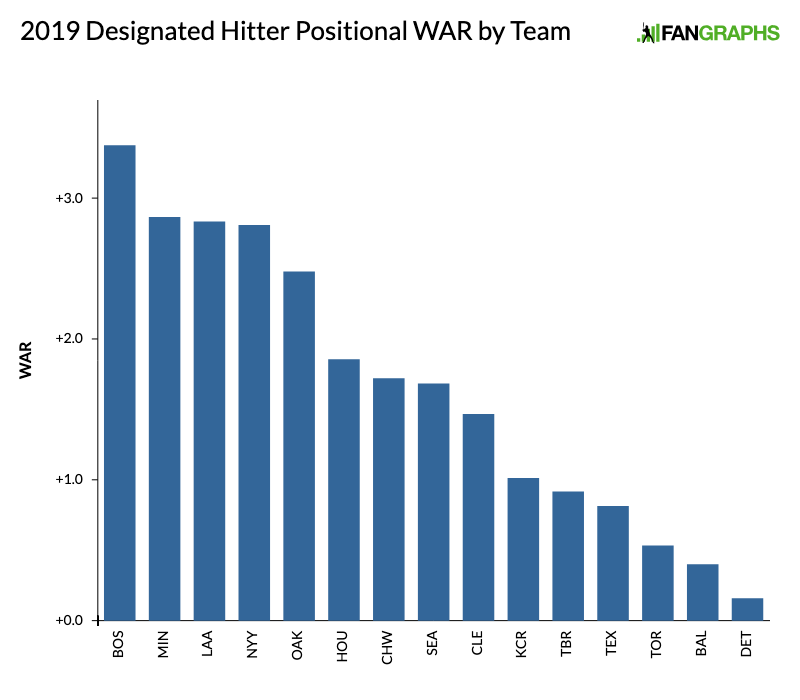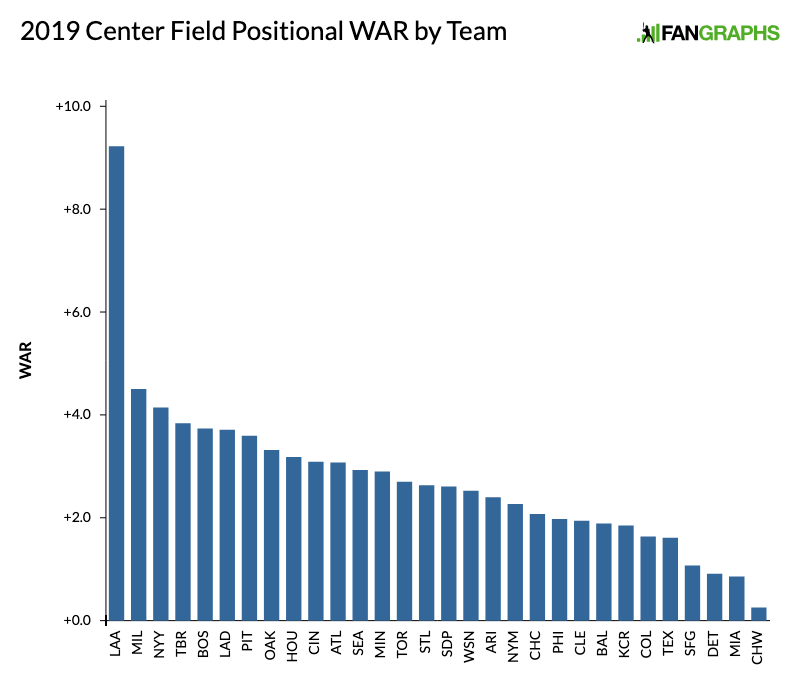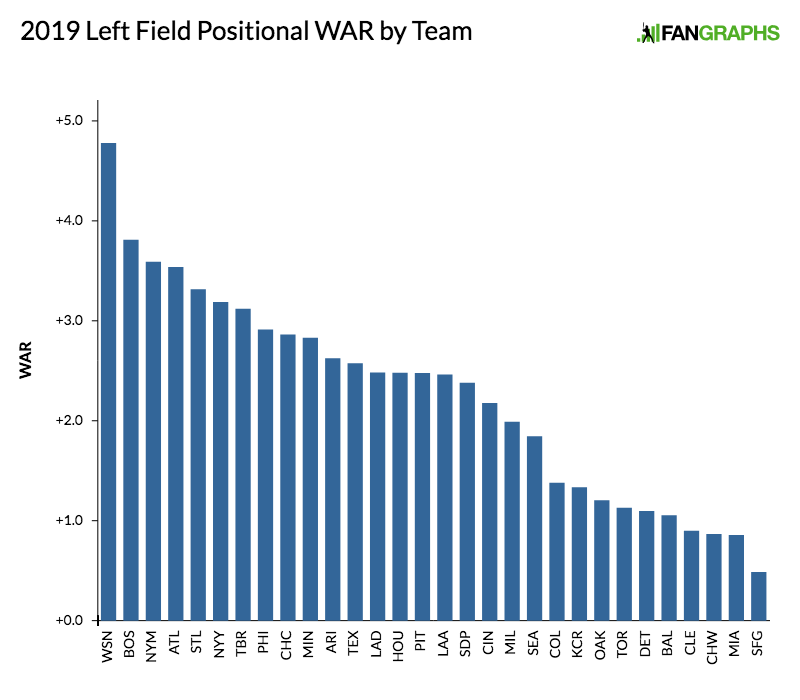2019 Positional Power Rankings: Summary
Over the past week and a half, we’ve published our annual preview of the upcoming season, ranking each position based on a blend of our projections (a 50/50 split between ZiPS and Steamer) and our manually maintained playing time estimates. The result was a document nearly the length of Infinite Jest (I am only somewhat kidding), so if you missed any of the posts, or would like to refresh your memory of what all it is that we’ve said, you can use the handy navigation widget above.
Today I’m going to summarize the results of the rankings. Before I get started, a brief note. I will throughout this post make reference to our Team WAR Totals. We maintain a total of projected future value by position, which updates regularly throughout the season. As such, the totals you see there may vary slightly from what you see on the positional power rankings, mostly because they are aware of injuries and transactions that have altered playing time estimates since the power rankings went live. I’ll provide a snapshot of those totals at the end of the post, but when you see that they are a little different here and there, don’t be surprised. Now you know why, and will be prepared. Now on to some trends.
First, we’ll take a look at where each team stacked up across positions. This table is sortable, so feel free to poke around.
| Team | C | 1B | 2B | 3B | SS | LF | CF | RF | SP | RP | DH |
|---|---|---|---|---|---|---|---|---|---|---|---|
| Angels | 25 | 27 | 22 | 22 | 4 | 16 | 1 | 22 | 18 | 23 | 3 |
| Astros | 18 | 22 | 1 | 2 | 3 | 15 | 9 | 12 | 3 | 2 | 6 |
| Athletics | 30 | 6 | 8 | 7 | 13 | 23 | 8 | 11 | 22 | 3 | 5 |
| Blue Jays | 7 | 11 | 29 | 10 | 26 | 24 | 14 | 14 | 21 | 21 | 13 |
| Braves | 6 | 1 | 2 | 9 | 17 | 4 | 11 | 26 | 20 | 18 | |
| Brewers | 1 | 9 | 5 | 13 | 28 | 19 | 2 | 3 | 24 | 17 | |
| Cardinals | 8 | 2 | 10 | 11 | 11 | 5 | 15 | 19 | 11 | 16 | |
| Cubs | 15 | 3 | 9 | 3 | 8 | 9 | 20 | 15 | 10 | 14 | |
| Diamondbacks | 16 | 18 | 11 | 16 | 16 | 11 | 18 | 21 | 15 | 25 | |
| Dodgers | 3 | 8 | 6 | 4 | 2 | 13 | 6 | 5 | 7 | 10 | |
| Giants | 2 | 7 | 14 | 26 | 10 | 30 | 27 | 28 | 25 | 7 | |
| Indians | 17 | 21 | 20 | 1 | 1 | 29 | 22 | 25 | 1 | 15 | 9 |
| Mariners | 29 | 25 | 26 | 25 | 23 | 20 | 12 | 7 | 19 | 28 | 8 |
| Marlins | 22 | 28 | 27 | 14 | 25 | 27 | 29 | 30 | 28 | 29 | |
| Mets | 10 | 13 | 3 | 21 | 15 | 3 | 19 | 10 | 6 | 5 | |
| Nationals | 20 | 20 | 13 | 6 | 5 | 1 | 17 | 6 | 4 | 9 | |
| Orioles | 28 | 30 | 30 | 29 | 30 | 26 | 23 | 27 | 30 | 20 | 14 |
| Padres | 9 | 16 | 15 | 5 | 19 | 17 | 16 | 16 | 17 | 13 | |
| Phillies | 4 | 5 | 17 | 28 | 14 | 8 | 21 | 4 | 12 | 4 | |
| Pirates | 13 | 17 | 18 | 15 | 29 | 14 | 7 | 18 | 9 | 6 | |
| Rangers | 26 | 26 | 23 | 27 | 22 | 12 | 26 | 23 | 23 | 12 | 12 |
| Rays | 14 | 19 | 16 | 19 | 20 | 7 | 4 | 24 | 8 | 8 | 11 |
| Red Sox | 19 | 23 | 19 | 20 | 6 | 2 | 5 | 1 | 5 | 27 | 1 |
| Reds | 23 | 4 | 21 | 12 | 21 | 18 | 10 | 8 | 16 | 22 | |
| Rockies | 21 | 12 | 24 | 8 | 7 | 21 | 25 | 17 | 13 | 26 | |
| Royals | 12 | 29 | 4 | 30 | 9 | 22 | 24 | 29 | 26 | 30 | 10 |
| Tigers | 27 | 24 | 28 | 24 | 27 | 25 | 28 | 20 | 27 | 24 | 15 |
| Twins | 11 | 14 | 12 | 17 | 18 | 10 | 13 | 13 | 14 | 11 | 2 |
| White Sox | 24 | 15 | 25 | 23 | 24 | 28 | 30 | 9 | 29 | 19 | 7 |
| Yankees | 5 | 10 | 7 | 18 | 12 | 6 | 3 | 2 | 2 | 1 | 4 |
Eight different teams check in with at least one first-place finish (the Angels, Astros, Braves, Brewers, Indians, Nationals, Red Sox, and Yankees). Only Cleveland (three) and Boston (two) can boast more than one such finish, though they present interesting and opposing case studies in how best to construct a roster. The Red Sox are one of eight teams (more on the others in a moment) that has six or more categories in which they rank in the top 10. The Red Sox are tops at both designated hitter and right field (J.D. Martinez and Mookie Betts: pretty good at baseball!) but are also sixth at shortstop, second in left field, fifth in center field, and fifth in their starting rotation. They have an incredibly deep, well-rounded team, though I would be remiss if I didn’t mention their bullpen, which came in at 27.
The only team among the eight I referenced above with a worse positional ranking was the Athletics, whose catching corps of Josh Phegley, Nick Hundley, Chris Herrmann, and Beau Taylor are projected to combine for a solitary win. Meanwhile, if you toggle over to the Team WAR Total projection for baseball’s remaining free agents, you’ll see that Craig Kimbrel accounts for 2.0 WAR of the All-Unemployed Team’s 2.2 relief WAR. He has the same projection as Edwin Diaz. The two of them only trail Aroldis Chapman and his 2.2 projected WAR. Those things are all facts that are being stated near to facts about the Boston Red Sox. Just some bullpen facts for your enjoyment.
Cleveland, on the other hand, has concentrated its wins rather sharply. Having Jose Ramirez and Francisco Lindor on the roster means the Indians are ranked first at third base and shortstop; Corey Kluber and Co. mean that their rotation is projected to be the best in baseball. But things fall of sharply from there. As I noted in my right field preview, Cleveland’s outfield is a mess, projected to be better than just the Tigers, Orioles, Royals, Giants, and Marlins in terms of its production across all three spots. They enjoy a weak division, but they also have a surprising thin margin for error given their advantage over bad competition, and it looks like their strategy will be tested early, with Ramirez dinged up while Lindor’s timeline for return is uncertain after he sustained an acute ankle sprain on Tuesday. Cleveland will almost certainly still find its way to October baseball (going into today, they had an 86.8% chance of winning their division according to our playoff odds), but its fate upon arriving there is far less assured.
I want to spend some time on the teams at the top and bottom of these rankings. The Yankees and Dodgers tally nine (nine!) positions a piece in those positions’ respective top 10s. The Astros can count seven. We’ve already talked about the Red Sox. That is impressive (there are five teams that don’t have a single top 10 finish), but it doesn’t necessarily give you a complete picture. The Cardinals are projected to win 86 games, tied for fifth-most in the NL with the Phillies, and they only have four top 10 finishes, as do the Giants, who we expect to win just 75 games. Ordinal rankings can make small differences appear larger than they are or obscure large gaps. But even with that proviso in mind, the Yankees and Dodgers impress. The Dodgers have four positions not just in the top 10, but the top five! They’re third at catcher, fourth at third base, second at shortstop, and fifth in right field. They don’t play with a designated hitter, being famously a National League team, but their projected 1.3 wins at DH in our Team WAR Totals page, which uses the expected value from pinch hitters to arrive at its NL DH forecast, is better than the Tigers’ 0.2 wins at the position, and the Tigers’ lineup is almost entirely composed of designated hitters playing out of position.
Meanwhile, the Yankees have a staggering six positions in that position’s top five. Their bullpen is first; their starting pitching is second. Right field comes in second; center field is in third. They’re fourth at DH and fifth at catcher. The Dodgers are projected for 93 wins and, despite an increasingly tough division, have an 85.9% chance of repeating as NL West champs. The Yankees have the best projected win total in baseball (97), and even with the Red Sox and Rays nipping at their heels, have a 62.2% chance of winning the division, not to mention the best odds to win the World Series. Contending teams can be balanced and pretty good at a lot of things, or they can be really good at a few things and cross their fingers about the rest. But the question the Yankees and Dodgers, and to a slightly lesser extent, the Astros and Red Sox, pose is: what if you were just really, really good at everything? Very good teams have faltered before, but at least on paper, this is the creme de la creme.
On the opposite end of the spectrum are the Orioles and the Marlins. The Orioles’ average power rankings position was 26.09; the Marlins’ was 25.90. If we were to pretend that Baltimore had suddenly transferred to the National League and thus lost the DH (at 14, it was their only position ranked in the teens or better), that average drops to 27.3. We don’t have to belabor the point; Orioles and Marlins fans have suffered enough. But jeez are they bad.
As we’ve discussed, the rankings by themselves are helpful, but not totally helpful. We need some additional context to see how close and far apart these are to get a better sense of relative strengths and weaknesses, and to see how the last week of activity and injury affects things (poor Steven Souza Jr.). Remember, the NL DH values reflect expected value from pinch-hitters.
| Team | C | 1B | 2B | SS | 3B | LF | CF | RF | DH | SP | RP | WAR |
|---|---|---|---|---|---|---|---|---|---|---|---|---|
| Angels | 1.6 | 0.8 | 1.9 | 4.8 | 2.5 | 2.5 | 9.2 | 1.8 | 2.8 | 9.1 | 1.8 | 39.0 |
| Astros | 2.3 | 1.4 | 5.0 | 5.1 | 5.6 | 2.5 | 3.2 | 2.9 | 1.9 | 16.3 | 4.6 | 50.8 |
| Athletics | 1.0 | 2.9 | 2.8 | 2.7 | 5.3 | 1.2 | 3.2 | 2.9 | 2.5 | 7.7 | 4.3 | 36.7 |
| Blue Jays | 3.4 | 2.1 | 1.3 | 1.7 | 4.5 | 1.1 | 2.7 | 2.5 | 0.5 | 7.8 | 1.9 | 29.6 |
| Braves | 3.6 | 4.6 | 4.1 | 2.3 | 4.9 | 3.5 | 3.1 | 1.0 | 0.5 | 8.7 | 2.3 | 38.6 |
| Brewers | 5.4 | 2.2 | 3.1 | 1.2 | 3.4 | 2.1 | 4.6 | 5.2 | 0.8 | 7.5 | 2.3 | 37.8 |
| Cardinals | 3.2 | 4.4 | 2.9 | 3.2 | 4.0 | 3.3 | 2.6 | 2.0 | 1.1 | 12.1 | 2.5 | 41.1 |
| Cubs | 2.4 | 4.3 | 3.0 | 3.8 | 5.5 | 2.9 | 2.1 | 2.5 | 0.9 | 12.6 | 2.6 | 42.5 |
| Diamondbacks | 2.4 | 1.6 | 2.8 | 2.4 | 2.8 | 2.6 | 2.6 | 0.4 | 0.7 | 11.2 | 1.7 | 31.2 |
| Dodgers | 4.5 | 2.5 | 3.4 | 5.5 | 5.4 | 2.5 | 3.7 | 4.0 | 1.3 | 14.3 | 2.9 | 50.0 |
| Giants | 5.1 | 3.0 | 2.4 | 3.2 | 2.1 | 0.4 | 1.0 | 0.4 | 0.4 | 6.9 | 3.2 | 28.2 |
| Indians | 2.3 | 1.4 | 2.2 | 6.5 | 6.2 | 0.9 | 2.0 | 1.2 | 1.5 | 19.4 | 2.6 | 46.2 |
| Mariners | 1.2 | 0.9 | 1.7 | 2.0 | 2.3 | 1.9 | 2.9 | 3.3 | 1.6 | 8.7 | 1.1 | 27.6 |
| Marlins | 1.9 | 0.3 | 1.6 | 1.7 | 3.3 | 0.9 | 0.9 | -0.2 | 0.5 | 6.9 | 0.9 | 18.8 |
| Mets | 3.0 | 2.1 | 3.3 | 2.4 | 2.6 | 2.6 | 2.3 | 3.0 | 0.9 | 15.5 | 4.1 | 42.0 |
| Nationals | 2.1 | 1.4 | 2.6 | 4.5 | 5.3 | 4.8 | 2.5 | 3.3 | 0.8 | 16.2 | 3.0 | 46.6 |
| Orioles | 1.1 | 0.1 | 1.6 | 1.1 | 1.5 | 1.1 | 1.9 | 0.7 | 0.3 | 5.2 | 2.0 | 16.5 |
| Padres | 3.0 | 1.6 | 2.4 | 2.1 | 5.4 | 2.3 | 2.6 | 2.3 | 0.8 | 10.1 | 2.7 | 35.1 |
| Phillies | 4.3 | 3.6 | 2.3 | 2.7 | 2.0 | 2.9 | 2.0 | 4.9 | 0.6 | 12.0 | 4.2 | 41.5 |
| Pirates | 2.6 | 1.6 | 2.2 | 1.1 | 3.1 | 2.5 | 3.6 | 2.2 | 0.9 | 12.6 | 3.8 | 36.2 |
| Rangers | 1.6 | 0.9 | 2.0 | 1.9 | 2.2 | 2.2 | 1.6 | 1.8 | 0.8 | 7.7 | 2.7 | 25.2 |
| Rays | 2.4 | 1.5 | 2.4 | 2.2 | 2.8 | 3.1 | 3.9 | 1.7 | 0.9 | 12.6 | 3.3 | 36.8 |
| Red Sox | 2.1 | 1.3 | 2.2 | 4.4 | 2.7 | 3.8 | 3.7 | 7.2 | 3.4 | 16.1 | 1.5 | 48.3 |
| Reds | 1.6 | 3.9 | 2.5 | 2.1 | 3.8 | 2.2 | 2.5 | 3.2 | 0.8 | 10.6 | 1.9 | 35.2 |
| Rockies | 2.1 | 2.0 | 1.9 | 3.9 | 5.0 | 1.4 | 1.6 | 2.3 | 0.5 | 12.0 | 1.5 | 34.1 |
| Royals | 2.7 | 0.3 | 3.1 | 3.6 | 0.3 | 1.3 | 1.7 | 1.2 | 0.8 | 6.6 | -0.4 | 21.2 |
| Tigers | 1.7 | 1.0 | 1.5 | 1.3 | 2.4 | 1.1 | 1.1 | 1.9 | 0.2 | 6.4 | 1.7 | 20.3 |
| Twins | 2.7 | 1.9 | 2.6 | 2.3 | 2.9 | 2.8 | 2.9 | 2.8 | 2.9 | 11.4 | 2.7 | 37.9 |
| White Sox | 1.6 | 1.7 | 1.7 | 1.8 | 2.5 | 0.7 | 0.3 | 3.0 | 1.7 | 5.5 | 2.1 | 22.5 |
| Yankees | 4.0 | 2.2 | 2.9 | 3.1 | 2.6 | 3.1 | 4.1 | 5.5 | 2.8 | 16.9 | 6.5 | 53.7 |
The Yankees are good. The Dodgers are good. The Astros, Red Sox, and Nationals are good. The Indians play in the AL Central. The Cubs and Cardinals are going to beat up on each other all season long; ditto the Phillies and Mets. The bad teams are very, very bad, and the middle is thin. It’s baseball in 2019. Tomorrow, real baseball with real stakes will be played in US time zones. We’ll look back and feel silly about some of these projections and haughty about others. We hope you’ve enjoyed this year’s installment of the positional power rankings and that the format provided you with something useful. We hope it helped to pass the time. We can’t wait to watch baseball along with all of you this season. It’s almost here.

